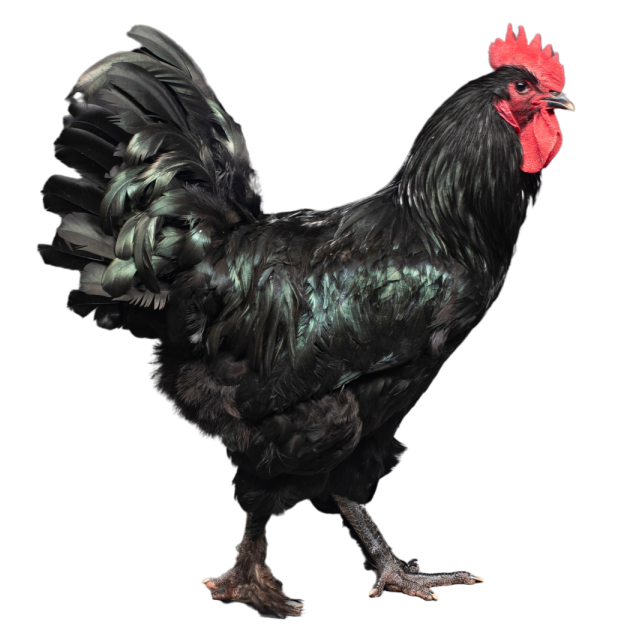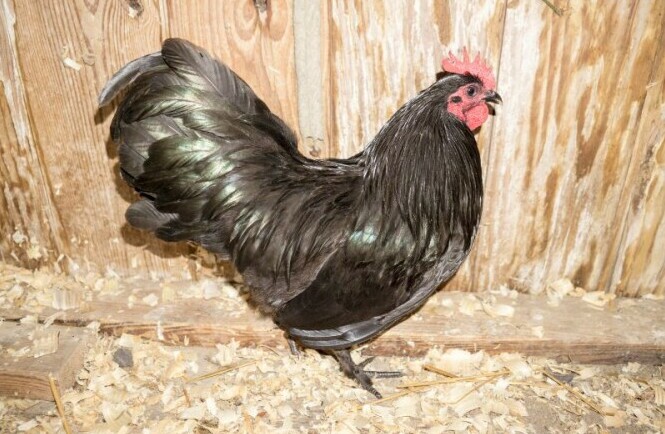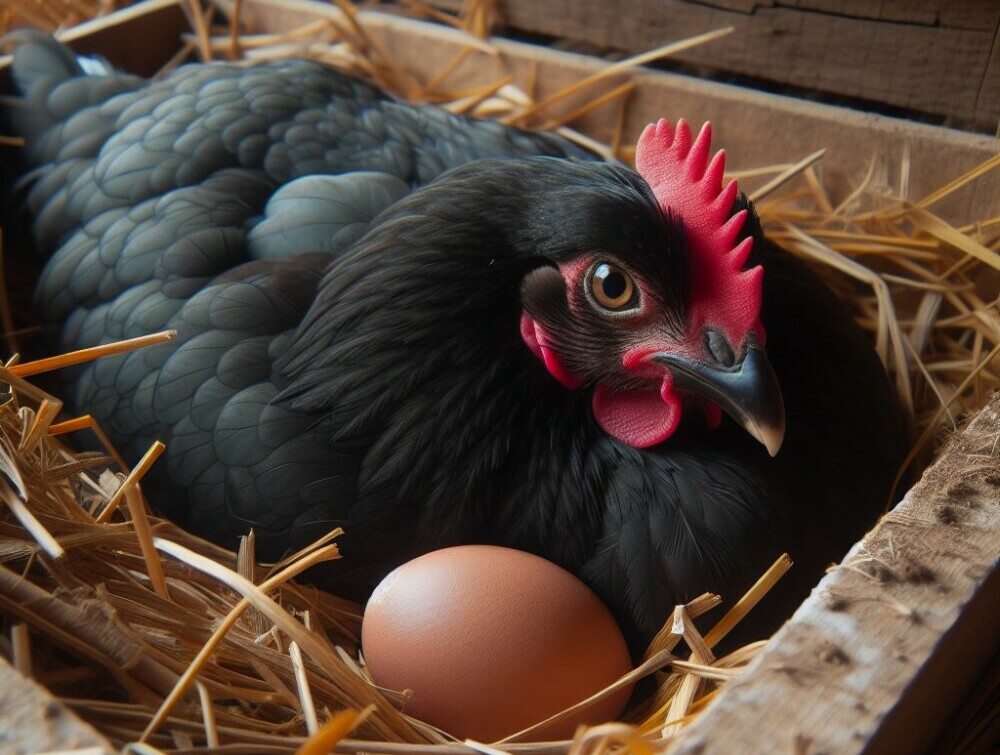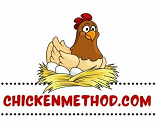Have you ever seen a chicken that looks like a furry, feathered football? That might be a Langshan chicken! These majestic birds are known for their calm personalities, large size, and unique, almost prehistoric appearance.

Unique Characteristics
Langshans are truly giants in the chicken world. These heavy birds can weigh up to 10 pounds, making them one of the largest breeds of chicken, along with the Giant Brahma and the Jersey Giant, to name others.
Their bodies are long and broad, with a distinctive “U-shaped” profile created by their sloping back and tall, upright tail.
Their feathery legs add to their impressive stature, and their single comb, wattles, and earlobes are typically a bright red. Langshans come in a variety of colors, with the most common being black. However, you can also find white, blue, and even lavender Langshans!

Temperament and Behavior
Don’t let their size scare you; Langshans are actually known for being gentle and docile birds.
They are calm and curious and often form strong bonds with their owners. Unlike some other large breeds, Langshans are not typically aggressive, making them a good choice for families with children.
These chickens are also intelligent and inquisitive. They are excellent foragers and enjoy exploring their surroundings. Langshans are also good at free-ranging, but ensuring their coop is secure and that they have plenty of space to roam is important.
Laying Abilities of Langshan Chickens
Langshans are surprisingly good layers for their large size. They can lay around 150-200 brown eggs per year, which is more than many other popular breeds.
However, their egg production slows down in colder months, so don’t expect a constant supply of fresh eggs during the winter.

Care and Maintenance
Langshans are relatively low-maintenance birds, but there are a few things you need to keep in mind to ensure their health and well-being. Here are some basic care tips:
Housing: Langshans need ample space to roam and explore. Their coop should be well-ventilated and predator-proof. Be sure to include plenty of nesting boxes and perches.
Feeding: Langshans need a high-quality feed formulated for large chickens. You can also supplement their diet with fresh fruits and vegetables.
Healthcare: Langshans are generally healthy birds but susceptible to some common chicken diseases, such as Marek’s disease and coccidiosis. It’s important to vaccinate your chickens and keep an eye out for signs of illness.
Positive Attributes
Beauty: Langshans are undoubtedly beautiful birds with unique appearances. They are sure to add a touch of class to your backyard flock.
Egg production: Langshans are good layers, producing large, brown eggs.
Calm temperament: Langshans are gentle and docile, making them a good choice for families with children.
Versatility: Langshans can be raised for both eggs and meat.
Low-maintenance: Langshans are relatively easy to care for.
Challenges of Raising Langshan Chickens
Size: Langshans are large birds requiring more space than other breeds.
Egg production: Langshans lay less during winter months.
Susceptibility to disease: Langshans are susceptible to some common chicken diseases.
How Do Langshans Get Along With Other Chickens?
Langshans are generally known to get along well with other chickens. They are not aggressive and tend to be peaceful and docile. However, like any breed, individual personalities can vary.
The following are guidelines for any chicken breed really, but I think it’s important to have this basic understanding to avoid unforeseen problems.
Introducing Langshans to an existing flock:
It’s important to introduce Langshans to an existing flock slowly and carefully. This will help to prevent any stress or fighting.
Quarantine new chickens for 30 days before introducing them to the rest of the flock. This will help to prevent the spread of disease.
Start by introducing the new chickens through a fence or mesh barrier. This will allow them to get used to each other without being able to interact directly.
Once the chickens seem comfortable with each other, you can start letting them spend short periods of time together in a supervised setting.
Gradually increase the amount of time the new chickens spend with the rest of the flock until they are fully integrated.
Factors to consider for compatibility:
Age and size: It’s best to introduce chickens of similar age and size to avoid any unwanted pecking order behavior.
Temperament: Observe the personalities of your existing chickens and choose Langshans with compatible temperaments.
Breed: Certain breeds, like Rhode Island Reds, can be more aggressive towards other chickens. Research the breed compatibility before introducing Langshans.
Here are some tips for creating a happy, harmonious flock:
Provide enough space: Overcrowding can lead to stress and aggression. Ensure your coop and run are large enough for all your chickens.
Offer plenty of food and water: Competition for resources can lead to fights. Make sure there are enough feeders and waterers for all your chickens.
Include hiding places: Chickens need places to escape from each other when they need a break. Provide plenty of bushes, trees, or other hiding places in your run.
Monitor your chickens regularly: Watch for signs of aggression or stress and intervene if necessary.
Langshans are generally peaceful birds that get along well with other chickens. However, it’s important to introduce them properly and provide a healthy environment to ensure your flock gets along.

Should I Add Langshans to My Flock?
Langshans are a wonderful breed of chicken for backyard flocks. They are beautiful, gentle, and productive. If you are looking for a large, docile bird that will provide you with plenty of eggs, Langshans are a great option.
Where You Can Find Out More Langshan Information
If you are interested in learning more about Langshan chickens, there are many resources available online and in libraries. You can also visit your local poultry club or hatchery to see Langshans in person.
Remember, raising chickens is a big responsibility. Before you bring home any chickens, be sure to do your research and ensure you can provide them with the proper care.
Additional Resources about Langshan Chickens:
Here are some links to reputable websites and organizations that provide additional information about Langshan chickens.
Breed Clubs and Associations:
The American Langshan Club: https://www.facebook.com/groups/1065802956802422/
The Langshan Club of Great Britain: http://www.croadlangshan.org.uk/
The Langshan Club of Australia: https://langshansaustralia.wixsite.com/australian-langshans
General Information:
The Livestock Conservancy: https://livestockconservancy.org/
Articles and Videos:
Keeping Langshan Chickens: https://croadlangshan.org/html/care.shtml
Social Media:
The American Langshan Club Facebook Page: https://www.facebook.com/groups/1065802956802422/
The Langshan Club of Great Britain Facebook Page: https://www.facebook.com/remygingembre/
Books:
The Langshan Chicken: A Complete Guide to Raising and Caring for Your Langshans: https://www.amazon.com/raising-chickens/s?k=raising+chickens
The Langshan Handbook: https://www.amazon.com/Handbook-Second-Language-Acquisition/dp/1405132817
The Backyard Homestead Guide to Raising Chickens: https://www.amazon.com/Beginners-Guide-Raising-Chickens-Backyard/dp/1641524057
I hope these resources provide you with valuable information about Langshan chickens!
Thanks for reading. I truly appreciate it. I would also appreciate it if you would leave any comments you have for me and other readers below.
Dave
Chickenmethod.com
